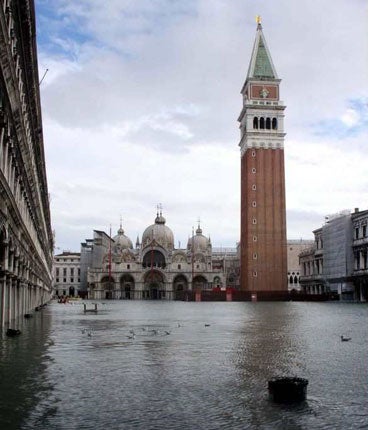The leaning tower of Venice to be propped up
Engineers aim to prevent repeat of great campanile collapse

The great Campanile of St Mark's Square, the highest and most famous structure in the piazza and for centuries the most famous symbol of Venice, is beginning to tilt.
Italian engineers will start work next month to stop the tower collapsing, as it did with little warning in 1902.
Sensors installed in the 98m tower prove that once again it is on the move and has shifted several millimetres in the past half century.
Engineers say that the corrosive effect of the salt water brought in by Venice's high tides is taking its toll on the wooden foundations that underpin the 13,000-ton red-brick tower.
Preparatory work inside the soaring medieval structure began in February 2007 but has been suspended for the past two months as the interested parties negotiated on the how to undertake the next, crucial stage, which involves bringing heavy and noisy machinery into the centre of St Mark's Square. Now agreement has been reached and the work is to start in January. It is expected to take two years.
The project is being co-ordinated by Consorzio Venezia Nuova, the state-appointed agency which is also responsible for the mobile barriers being constructed at the entrance of the lagoon to block high tides.
The Consorzio's press officer said that the campanile – which has a lift to take visitors to the top – will remain open throughout the works. However, the charm of the famous piazza, "the fairest and goodliest prospect that is (I thinke) in all the world" as an early English visitor called Thomas Coryate called it, will be seriously disrupted.
The heavy machinery makes its entrance in January when the firm of ThyssenKrupp from Terni in central Italy sets about strapping a 12-ton underground belt made of titanium around the building's foundations, 3.5m below ground. The idea is that this will counterbalance any tilting tendencies and keep the campanile upright more or less indefinitely.
The campanile was, as the Literary Companion to Venice reminds us, where Galileo first demonstrated his telescope to the Doge and where Goethe, on reaching the top, first saw the sea. But the disaster of July 1902 brought home to Venetians the fact that it needs to be closely watched.
An American architect who witnessed the 1902 event wrote: "Workmen had been repointing the campanile and had discovered a bad crack ... The crack had shown signs of opening further, and they feared small fragments falling on the crowded piazza; so the music (in the piazza) was quietly stopped in the hope that the crowd would naturally disperse. The effect was exactly the opposite."
He was near the Rialto bridge when the tower fell. "The golden Angel on the tower was shining far away. Suddenly I saw it sink directly downwards behind a line of roofs, and a dense grey dust rose in clouds ... all that remained was a mound of white dust, spreading to the walls of St Mark's."
The reconstruction effort took almost 10 years and the new tower was built to be identical to the original.
Join our commenting forum
Join thought-provoking conversations, follow other Independent readers and see their replies
Comments